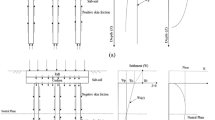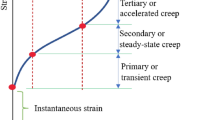Abstract
A roadway roof has compound and cataclastic features when tunneling a roadway under a gob with top remains in downward mining. To identify the self-bearing characteristics and to develop a control strategy for a regenerated roadway roof with top remains (RRRTR), mechanical and numerical models of a RRRTR were built on the basis of a structural model of a compound and cataclastic roof. Through a theoretical analysis and numerical simulations, the formation and instability criterion of a three-hinged arch in a RRRTR were analyzed. Meanwhile, the self-bearing characteristics of a RRRTR with various crack spacing values in the top remains were studied. On this basis, a bolt-net-belt (BNB) support scenario was proposed to control the RRRTR and an on-site roof subsidence monitoring task was conducted. The theoretical and numerical analyses both indicate that a three-hinged arch exists in the roadway top remains, and it has a certain bearing capacity. The compressive failure of the hinge points is an instability trigger of a three-hinged arch that would trigger the entire failure of the RRRTR. The crack spacing values of the top remains influenced the formation and bearing capacity of the three-hinged arch. The three-hinged arch is easier to establish and has a better bearing effect when the top remains have a larger crack spacing value. The BNB support scenario could not only control the roof subsidence but also facilitate the potential self-bearing capability of the RRRTR.


























Similar content being viewed by others
References
Bai QS, Tu SH (2016) Failure analysis of a large span longwall drift under water-rich roofs and its control techniques. Eng Fail Anal 67:15–32
Cai WY, Chang ZC, Zhang DS, Wang XF, Cao WH, Zhou YZ (2019) Roof filling control technology and application to mine roadway damage in small pit goaf. Int J Min Sci Technol 29(3):477–482
Ding K, Gu ST, Guo JX, Gu D, Liu Z, Wei BZ (2019) Numerical investigation on factors affecting stability of roadway surrounding rock with fractured roof. Geotech Geol Eng 37(4):2373–2385
Hao XJ, Zhao YX, Li YL, Guo YD, Ren B (2018) Simulation of sidewall failure in coal mine roadways using an extended continuous joint model. J Fail Anal Prev 18(1):41–49
He FL, Yang BD, Yin SF, Wang X, Tian CY (2011) Study on safety technology of anti-caving at a super-large section roadway with thick and fractural coal roof. Procedia Eng 26:545–553
Hu XY, Fang Y, Walton G, He C (2019) Analysis of the behavior of a novel support system in an anisotropically jointed rock mass. Tunn Undergr Space Technol 83:113–134
Jiang BY, Wang LG, Lu YL, Gu ST, Sun XK (2015) Failure mechanism analysis and support design for deep composite soft rock roadway: a case study of the Yangcheng Coal Mine in China. Shock Vibr 2015:1–14. https://doi.org/10.1155/2015/452479
Jiao YY, Song L, Wang XZ, Adoko AC (2013) Improvement of the U-shaped steel sets for supporting the roadways in loose thick coal seam. Int J Rock Mech Min Sci 60(2):19–25
Lai XP, Ren FH, Wu YP, Cai MF (2009) Comprehensive assessment on dynamic roof instability under fractured rock mass conditions in the excavation disturbed zone. Int J Miner Metall Mater 16(1):113–134
Li XB, Zhou ZL, Li QY, Hu LQ (2005) Parameter analysis of anchor bolt support for large-span and jointed rock mass. J Cent South Univ Technol 12(4):483–487
Liu HT, Ma NJ, Zhao FH, Liu FM (2010) New bolting structure of fractured roof based on the Bossinesq equations. Min Sci Technol 20(2):260–265
Lu YL, Wang LG, Zhang B (2012) Roadway failure and support in a coal seam underlying a previously mined coal seam. Int J Min Sci Technol 22(5):619–624
Ma WQ, Wang TX (2019a) Experimental study of shear strength features of regenerated rock mass compacted and consolidated by broken soft rocks. KSCE J Civ Eng 23(4):1839–1848
Ma WQ, Wang TX (2019b) Instability mechanism and control countermeasure of a cataclastic roadway regenerated roof in the extraction of the remaining mineral resources: a case study. Rock Mech Rock Eng 52(7):2437–2457
Ma ZQ, Jiang YD, Du WS, Zuo YJ, Kong DZ (2018) Fracture evolution law and control technology of roadways with extra thick soft roof. Eng Fail Anal 84:331–345
Ma Q, Zhao ZH, Gao XJ, Chen SJ, Tan YL (2019) Numerical survey on the destabilization mechanism of weakly cemented soft rock roadway considering interlayer effect. Geotech Geol Eng 37(1):95–105
Su CQ (2011) Numerical analysis on stability of surrounding rock mass around deep roadway. J Coal Sci Eng 17(4):377–381
Tu HS, Tu SH, Wang C, Hao DY, Zhu DF (2018) Mechanical analysis of a vertical-wall, semicircular-arch roadway and a repair technique using double-shell support. Environ Earth Sci 77:509
Wang FT, Zhang C, Wei SF, Zhang XG, Guo SH (2016) Whole section anchor-grouting reinforcement technology and its application in underground roadways with loose and fractured surrounding rock. Tunn Undergr Space Technol 51(1):133–143
Wang Q, Pan R, Jiang B, Li SC, He MC, Sun HB, Wang L, Qin Q, Yu HC, Luan YC (2017) Study on failure mechanism of roadway with soft rock in deep coal mine and confined concrete support system. Eng Fail Anal 81:155–177
Yang XX, Jing HW, Chen KF (2016) Numerical simulations of failure behavior around a circular opening in a non-persistently jointed rock mass under biaxial compression. Int J Min Sci Technol 26(4):729–738
Yu SF, Wu AX, Wang YM, Li T (2017a) Pre-reinforcement grout in fractured rock masses and numerical simulation for optimizing shrinkage stoping configuration. J Cent South Univ 24(12):2924–2931
Yu WJ, Wang WJ, Wu GS, Yu XY, Peng WQ (2017b) Three-zones and support technique for large section incline shaft crossing goaf. Geotech Geol Eng 35(5):1921–1931
Yu WJ, Wu GS, An BF (2017c) Investigations of support failure and support for soft and fractured coal-rock tunnel in tectonic belt. Geotech Geol Eng 36(6):3911–3929
Zhong ZB, Deng RG, Lv L, Fu XM, Yu J (2018) Fracture mechanism of naturally cracked rock around an inverted U-shaped opening in a biaxial compression test. Int J Rock Mech Min Sci 103:242–253
Acknowledgements
This research is financially supported by the Key Scientific Research Projects of Higher Education Institutions in Henan Province (Grant No. 20A560019), the Nanhu Scholars Program of Xinyang Normal University and the Natural Science Foundation of China (Grant No. 41807240). The author gratefully acknowledges the financial support provided by them.
Author information
Authors and Affiliations
Corresponding author
Additional information
Publisher's Note
Springer Nature remains neutral with regard to jurisdictional claims in published maps and institutional affiliations.
Rights and permissions
About this article
Cite this article
Ma, W., Wang, Z. & Wang, T. Self-bearing Characteristics and Control Strategy of a Cataclastic Regenerated Rock Mass in a Roadway Roof with Top Remains: A Case Study. Geotech Geol Eng 38, 3853–3873 (2020). https://doi.org/10.1007/s10706-020-01262-0
Received:
Accepted:
Published:
Issue Date:
DOI: https://doi.org/10.1007/s10706-020-01262-0




